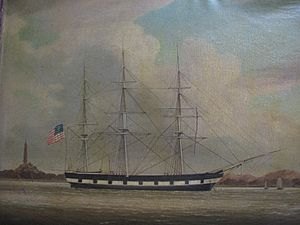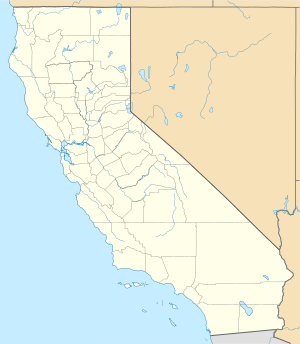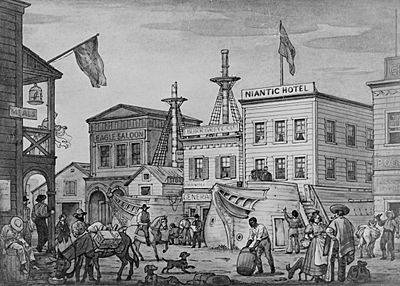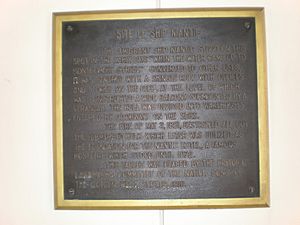Niantic (whaling vessel) facts for kids

Painting of Niantic at the Whampoa anchorage near Canton
|
|
| History | |
|---|---|
| Builder | Connecticut |
| In service | 1832 |
| Out of service | 1849 |
| Renamed | Niantic Hotel, 1849 |
| Fate |
|
| General characteristics | |
| Type | ship or barque |
| Tons burthen | "could probably take eight or nine hundred tons in storage" |
| Length | 119 ft 6 in (36.42 m) |
| Beam | 29 ft (8.8 m) |
| Depth of hold | 19 ft 6 in (5.94 m) |
| Propulsion | Sail |
| Complement | 28 |
|
Niantic (Storeship)
|
|
| Location | NW corner of Clay and Sansome Sts., San Francisco, California |
| Area | 0.1 acres (0.040 ha) |
| Architect | Childs, Thomas |
| NRHP reference No. | 91000563 |
| Added to NRHP | 16 May 1991 |
The Niantic was a famous whaling ship that sailed the seas long ago. It became very important during the exciting California Gold Rush in 1849. This ship brought many people, called "fortune-seekers," to Yerba Buena. This place was later renamed San Francisco.
Once it arrived, the Niantic was pulled ashore and turned into a floating warehouse and even a hotel. It became a well-known landmark in the fast-growing city for several years. Today, the spot where the Niantic rested, near the Transamerica Pyramid, is a special California Historical Landmark. You can see parts of the ship and its old logbook at the San Francisco Maritime Museum.
Contents
The Niantic's Early Life
The Niantic was built in 1832 in Connecticut. It was first designed to trade goods with China. In 1840, the ship was owned by N. L. and G. Griswold from New York.
In 1840, the Niantic sailed from Canton (a port in China). It carried valuable tea and silk. The ship managed to avoid a blockade by the British navy. This blockade was part of the First Opium War. This trip was likely the most profitable one for the Niantic as a merchant ship.
Becoming a Whaling Ship
In 1844, the Niantic was bought by C. T. Deering. He changed it into a whaling ship. In June 1844, it left Sag Harbor for a long whaling trip in the Pacific Ocean. This journey lasted almost three years. The ship returned to Sag Harbor in February 1847.
In 1847, a company called Burr & Smith bought the Niantic. On September 16, 1848, it sailed from Warren, Rhode Island. Captain Henry Cleaveland was in charge. His sons, James and Daniel, were also officers on the ship. They were part of the famous Cleaveland whaling family. The ship's name, Niantic, came from the Niantic people, a Native American tribe.
Race to California in 1849
In January 1849, the Niantic sailed around Cape Horn, the southern tip of South America. It stopped in Paita, Peru, on March 8. There, the captain received an important letter. The American consul in Panama asked them to carry passengers to San Francisco.
Gold Rush Passengers
Many people, called "Argonauts" (like the heroes from Greek myths), had crossed the Isthmus of Panama. They were waiting on the Pacific coast for a ride to California. The Gold Rush had just started! The ship was quickly changed to carry passengers both above and below deck.
On March 25, the Niantic left Paita for Panama. It carried 150 mules, potatoes, and lots of wood. It arrived on the Panama coast on April 8. After nearly four weeks of preparations, it left for San Francisco on May 2. There were 246 passengers on board. Sixteen passengers paid $250 each, and others paid $150. This meant the ship earned a lot of money from passenger fees.
A Clever Captain
Captain Cleaveland knew the Pacific winds very well from his whaling trips. This gave him an advantage over other ships. For 28 days, he sailed southwest, even though the passengers complained. He was waiting to catch the strong southeast trade winds. On May 24, he caught them, and on May 30, he turned northwest.
Because of the captain's clever sailing, the Niantic was one of the first ships to bring gold seekers to San Francisco. It arrived late on July 5, 1849.
From Ship to Hotel
When the Niantic reached San Francisco harbor, most of its crew quickly left. They wanted to join the Gold Rush and find gold themselves! The ship's logbook shows that many crew members deserted in just a few days. Some were even arrested for fighting the captain.
Without a crew, the Niantic's owners decided to sell the ship. They used empty whale oil barrels tied to the hull to make the ship float higher. Then, they moved it into shallow water near Clay and Montgomery Streets. Once it was stuck in the mud, the Niantic was turned into a warehouse, a store, offices, and even a hotel.
A famous sign was put over a new doorway cut into the ship's side. It read: "Rest for the weary and storage for trunks." At first, people used a pier to reach the ship. But later, the sandy hills around the ship were flattened, and the water was filled in. The Niantic was now on dry land!
Fires and Rebuilding
The new city of San Francisco had many big fires in the early 1850s. The converted Niantic burned several times in these fires. But each time, it was rebuilt as the Niantic Hotel. With each rebuild, it looked less and less like a ship. Around 1852, the Niantic Hotel was known as the best hotel in San Francisco.
Niantic's Lasting Legacy
The hull of the Niantic was found again in 1872 when the old Niantic Hotel was torn down. Thirty-five baskets of champagne bottles were discovered in the ruins!
In 1907, the Niantic was found once more. This happened during rebuilding after the terrible San Francisco Fire of 1906. A new building, also called the Niantic Building, was constructed.
A special plaque was placed at 505 Sansome at Clay Street on September 19, 1919. It marks the historic spot where the Niantic once rested.
1978 Excavation
The Niantic was rediscovered again in 1978. This was during digging for a new building complex near the Transamerica Pyramid. This spot is now about six blocks away from the waterfront! The digging had to be done quickly, so there wasn't much time to study or save everything.
One last basket of champagne bottles was found deep inside the burned remains of the ship. One of these bottles was given to Dionis Coffin Riggs. She was the great-granddaughter of Captain Cleaveland. This was a thank you for donating the ship's logbook to the researchers.
Some parts of the Niantic were taken to a landfill. But a part of the ship's front (the bow) is still hidden under a parking lot today.
California Historic Landmark
The exact location of the Niantic is recognized as California Historical Landmark #88. This means it's a very important historical site in California.
San Francisco Maritime Museum
You can see a part of the Niantic's hull and rudder at the San Francisco Maritime Museum. There are also other items from the ship on display. This includes the ship's logbook, which was kept by First Mate James Cleaveland. It records the ship's arrival in San Francisco. A special model shows how the ship looked in 1850 when it was a storeship.
Niantic, Inc.
In 2010, a company called Niantic, Inc was started. This company develops exciting Augmented Reality games for smartphones. Based in San Francisco, they named their company after the historic Niantic ship. Niantic, Inc. created popular games like Ingress, Pokémon GO, and Harry Potter: Wizards Unite.




